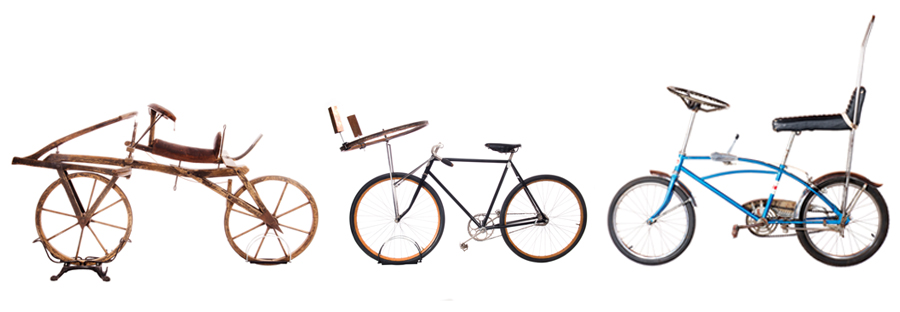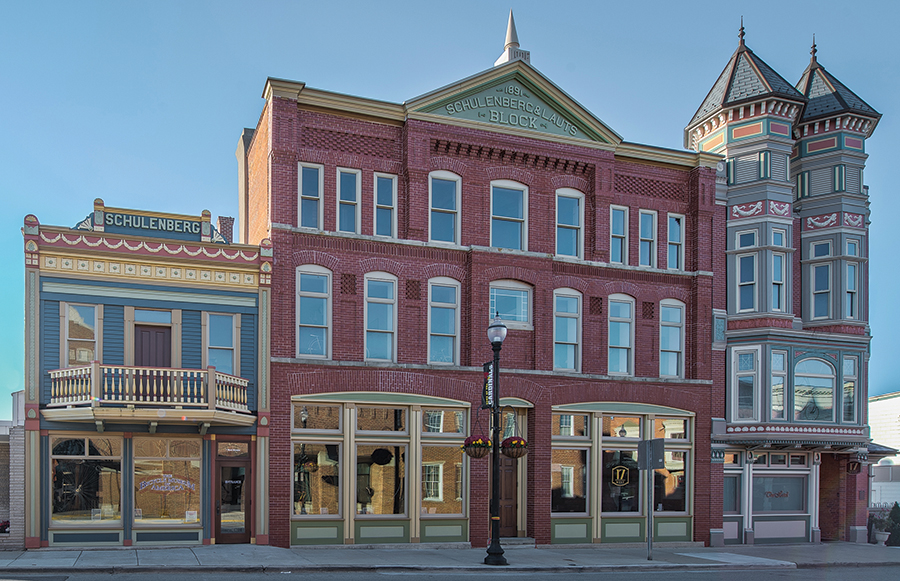Backpedaling into History
This article first appeared in the June 2021 issue of Adventure Cyclist magazine.
The Bicycle Museum of America sits in the little town of New Bremen in west-central Ohio and houses perhaps the most extensive collection of Schwinn bikes in the world, along with what is generally recognized as the first iteration of the bicycle: the 1816 Draisine.
“There are about eight left in the world, and ours is 75 percent original,” said Museum Coordinator Ryan Long. “They originated in Germany and were built by Karl von Drais.”
The “bicycle” is made of wood — including the wheels — and resembles a wheelbarrow with two wheels instead of one and a tiller to hold onto. There’s a saddle-like seat and a raised leather pad to rest your arms on while grasping the tiller.
“It’s basically a log with wheels on it,” Long said. “There’s no way to steer it except to just lean into a turn. Very primitive.”

As the museum website explains, the genesis of the Draisine was the volcanic eruption of Mt. Tambora in Indonesia, which led to a drop in global temperatures and famine across Europe.
No longer able to depend on his horses and livestock, von Drais built the Draisine as a way to get around by essentially running in place. There were no pedals or drivetrain.
“The invention exploded in popularity, quickly becoming the envy of high society across Europe’s largest cities,” the website explains. “The bicycle would soon influence every aspect of life in the 19th and 20th centuries.”
Not a bad origin story for the bicycle: a volcanic eruption that changed the world. The genesis story for the Bicycle Museum of America is not quite as apocalyptic, but it does involve the collapse of an icon of American bicycles: Schwinn.
The company was founded in Chicago in 1895 by Ignaz Schwinn, also born in Germany. Schwinn went on to become the dominant bicycle brand in the U.S. for decades, flourishing especially after World War II, according to Long.
“They really did it with the Phantom line with the balloon tires,” Long said. “They were large cruiser-type bicycles, the first ones with balloon tires and big tanks. They kind of had a space-age look to them.”
At the other end of the spectrum, Schwinn also became famous for the Campagnolo-equipped Paramount racing bike, an example of which the museum also has.
Despite its success, Schwinn filed for bankruptcy in October 1992, a victim of its inability to recognize a changing market that valued light weight and performance over tradition, according to a story in the Los Angeles Times. The company’s share of the market had fallen to 7 percent, from its 25 percent share “during its 1950s heyday,” the Times reported.
With the bankruptcy, the Schwinn family decided to sell its collection of bicycles that were housed in a museum located in Chicago’s North Pier, a retail and office complex. Another dynasty, the Dicke family of Crown Equipment in New Bremen, Ohio, stepped in to buy the collection and move it to their hometown.
Crown is the fifth largest manufacturer of industrial lift trucks in the world. The privately held company has annual revenues of nearly $4 billion, with more than 16,000 employees worldwide.
“They bought almost the entire collection from the Schwinn family and brought it here as a tourist attraction,” Long said. “We have about 130 bikes on display with a little under 800 in the entire collection.

The museum in New Bremen takes up three floors of a historic building that was once a furniture store. The first floor shows the evolution of the bicycle and “goes into detail about the bicycle boom and bust of the 1890s,” Long said.
“There’s a bit of local history, a New Bremen Civil War flag, and some Crown history here too,” he added.
The first-floor collection includes an 1870 “Boneshaker,” an evolution of the Draisine that involved enlarging the front wheel and directly attaching pedals to it.
“The combination of the wheels with the cobblestone roads proved to make an extremely uncomfortable ride, earning the name ‘Boneshaker,’” the museum website says.
The collection also includes a “penny farthing” bicycle from the High Wheel Era, which began in the 1870s. The large front wheel meant much more ground could be covered with each rotation of the pedals, which were still directly attached to the front wheel, but afforded a smoother ride than its predecessor. The high wheel was, however, tricky to mount.
The first bikes that look remotely similar to today’s bikes were the so-called “safety bikes,” introduced in 1886. Although it doesn’t exactly have the double-diamond frame of modern bikes, it has something similar, and most importantly it has a chain drive, which “allowed for increased efficiency in power,” the museum website states.
“The safety bicycle was also able to be mass-produced and so became affordable for the average worker,” the website continues. “The bicycle was no longer the prize of high society, as people in every class could now experience the freedom and joys of riding.”
The second floor of the bicycle museum is devoted to professional cycling history, covering racing from its beginnings, including some racing high wheels, and a display featuring Major Taylor, a Black man who rose to the pinnacle of the sport despite facing racial prejudice.
“It goes from antiquity to now,” Long said of the second-floor exhibitions.
The exhibitions include a Tortola Roundtail, a bizarre bicycle from a Canadian inventor that replaces the rear triangle of the traditional double-diamond bicycle frame with two round hoops.
“The idea is that instead of the seatstays transferring impacts and road buzz straight to your posterior, they’re dispersed by the shock-absorbing rings,” BikeRadar reported in an April 2011 review.
Long couldn’t comment one way or the other on whether the design works. “I’ve never ridden it myself,” he said.
Another oddity on the second floor is one of the bikes from the movie Pee-wee’s Big Adventure.
The third floor of the bicycle museum includes the military history of bicycles and more Schwinns as well as Huffys, the other big name in American bicycles, which were cheaper and heavier than Schwinns.
“You would find Huffy at K-Mart,” Long said.
Visitors to the museum, which average 7,000 to 9,000 annually, are bicycle enthusiasts from around the world. Long said that recently he welcomed visitors from Germany, Australia, China, and New Zealand. He attributes the worldwide appeal to the museum’s unique collection.
“We have some one-of-a-kind pieces here you won’t see anywhere else,” Long said. “If you’re a fan of history, a fan of bicycles, it’s a great place to come.”


